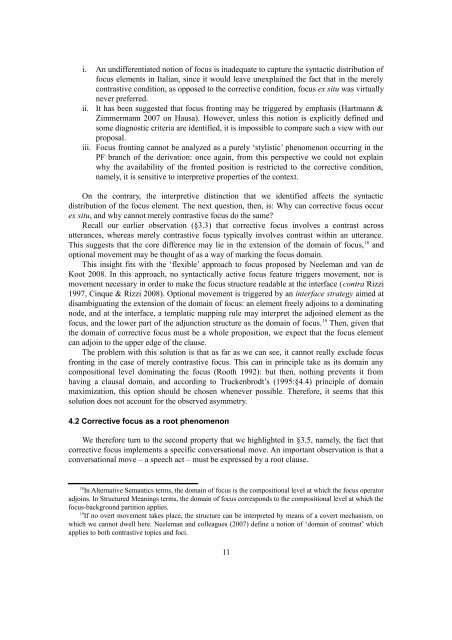Empirical Issues in Syntax and Semantics 9 (EISS 9 ... - CSSP - CNRS
Empirical Issues in Syntax and Semantics 9 (EISS 9 ... - CSSP - CNRS
Empirical Issues in Syntax and Semantics 9 (EISS 9 ... - CSSP - CNRS
Create successful ePaper yourself
Turn your PDF publications into a flip-book with our unique Google optimized e-Paper software.
i. An undifferentiated notion of focus is <strong>in</strong>adequate to capture the syntactic distribution of<br />
focus elements <strong>in</strong> Italian, s<strong>in</strong>ce it would leave unexpla<strong>in</strong>ed the fact that <strong>in</strong> the merely<br />
contrastive condition, as opposed to the corrective condition, focus ex situ was virtually<br />
never preferred.<br />
ii.<br />
It has been suggested that focus front<strong>in</strong>g may be triggered by emphasis (Hartmann &<br />
Zimmermann 2007 on Hausa). However, unless this notion is explicitly def<strong>in</strong>ed <strong>and</strong><br />
some diagnostic criteria are identified, it is impossible to compare such a view with our<br />
proposal.<br />
iii. Focus front<strong>in</strong>g cannot be analyzed as a purely ‘stylistic’ phenomenon occurr<strong>in</strong>g <strong>in</strong> the<br />
PF branch of the derivation: once aga<strong>in</strong>, from this perspective we could not expla<strong>in</strong><br />
why the availability of the fronted position is restricted to the corrective condition,<br />
namely, it is sensitive to <strong>in</strong>terpretive properties of the context.<br />
On the contrary, the <strong>in</strong>terpretive dist<strong>in</strong>ction that we identified affects the syntactic<br />
distribution of the focus element. The next question, then, is: Why can corrective focus occur<br />
ex situ, <strong>and</strong> why cannot merely contrastive focus do the same?<br />
Recall our earlier observation (§3.3) that corrective focus <strong>in</strong>volves a contrast across<br />
utterances, whereas merely contrastive focus typically <strong>in</strong>volves contrast with<strong>in</strong> an utterance.<br />
This suggests that the core difference may lie <strong>in</strong> the extension of the doma<strong>in</strong> of focus, 18 <strong>and</strong><br />
optional movement may be thought of as a way of mark<strong>in</strong>g the focus doma<strong>in</strong>.<br />
This <strong>in</strong>sight fits with the ‘flexible’ approach to focus proposed by Neeleman <strong>and</strong> van de<br />
Koot 2008. In this approach, no syntactically active focus feature triggers movement, nor is<br />
movement necessary <strong>in</strong> order to make the focus structure readable at the <strong>in</strong>terface (contra Rizzi<br />
1997, C<strong>in</strong>que & Rizzi 2008). Optional movement is triggered by an <strong>in</strong>terface strategy aimed at<br />
disambiguat<strong>in</strong>g the extension of the doma<strong>in</strong> of focus: an element freely adjo<strong>in</strong>s to a dom<strong>in</strong>at<strong>in</strong>g<br />
node, <strong>and</strong> at the <strong>in</strong>terface, a templatic mapp<strong>in</strong>g rule may <strong>in</strong>terpret the adjo<strong>in</strong>ed element as the<br />
focus, <strong>and</strong> the lower part of the adjunction structure as the doma<strong>in</strong> of focus. 19 Then, given that<br />
the doma<strong>in</strong> of corrective focus must be a whole proposition, we expect that the focus element<br />
can adjo<strong>in</strong> to the upper edge of the clause.<br />
The problem with this solution is that as far as we can see, it cannot really exclude focus<br />
front<strong>in</strong>g <strong>in</strong> the case of merely contrastive focus. This can <strong>in</strong> pr<strong>in</strong>ciple take as its doma<strong>in</strong> any<br />
compositional level dom<strong>in</strong>at<strong>in</strong>g the focus (Rooth 1992): but then, noth<strong>in</strong>g prevents it from<br />
hav<strong>in</strong>g a clausal doma<strong>in</strong>, <strong>and</strong> accord<strong>in</strong>g to Truckenbrodt’s (1995:§4.4) pr<strong>in</strong>ciple of doma<strong>in</strong><br />
maximization, this option should be chosen whenever possible. Therefore, it seems that this<br />
solution does not account for the observed asymmetry.<br />
4.2 Corrective focus as a root phenomenon<br />
We therefore turn to the second property that we highlighted <strong>in</strong> §3.5, namely, the fact that<br />
corrective focus implements a specific conversational move. An important observation is that a<br />
conversational move – a speech act – must be expressed by a root clause.<br />
18<br />
In Alternative <strong>Semantics</strong> terms, the doma<strong>in</strong> of focus is the compositional level at which the focus operator<br />
adjo<strong>in</strong>s. In Structured Mean<strong>in</strong>gs terms, the doma<strong>in</strong> of focus corresponds to the compositional level at which the<br />
focus-background partition applies.<br />
19<br />
If no overt movement takes place, the structure can be <strong>in</strong>terpreted by means of a covert mechanism, on<br />
which we cannot dwell here. Neeleman <strong>and</strong> colleagues (2007) def<strong>in</strong>e a notion of ‘doma<strong>in</strong> of contrast’ which<br />
applies to both contrastive topics <strong>and</strong> foci.<br />
11











